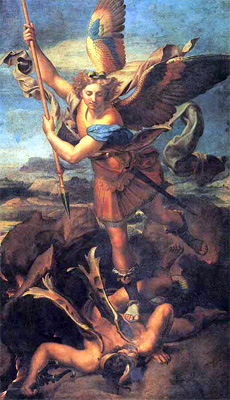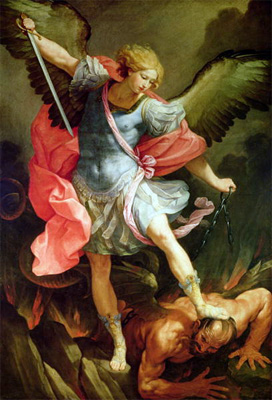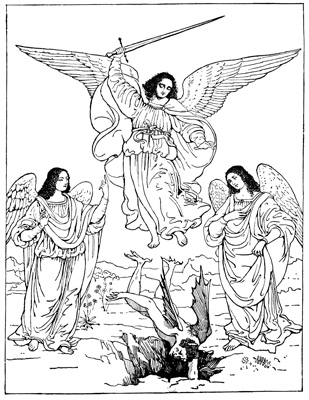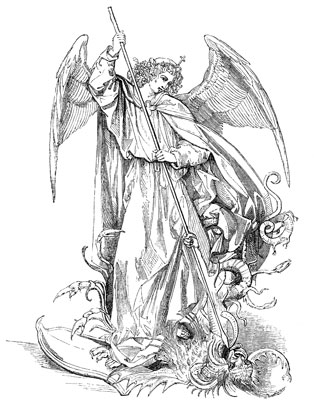The Archangel Michael is reverenced as the first and mightiest of all created beings. He was worshiped by the Chaldeans, and the Gnostics taught that he was the leader of the seven angels who created the universe. After the Captivity the Hebrews regarded him as all that is implied by the Prophet Daniel when he says, “Michael, the great prince which standeth for the children of thy people.” It is believed that he will be privileged to exalt the banner of the Cross on the Judgment Day, and to command the trumpet of the archangel to sound; it is on account of these offices that he is called the “Bannerer of Heaven.”
As captain of the heavenly host, it devolved on Michael to conquer Lucifer and his followers, and to expel them from heaven after their refusal to worship the Son of Man ; and terrible was the punishment he inflicted on them. Chained in mid-air, where they must remain until the Judgment Day, they behold all that happens on earth. Man, whom they disdained, has flourished in their sight, and wields a power that they may well envy, while the souls of the redeemed constantly ascend to the heaven which is closed to them. Thus are they constantly tormented by hate, and a desire for revenge, of which they must ever despair.
St. Michael is represented in art as young and severely beautiful. In the earliest pictures his drapery is always white and his wings of many colors, while his symbols, indicating that his conquests are made by spiritual force alone, are a lance terminating in a cross, or a sceptre. Later, it became the custom to represent him in a costume and with such emblems as indicated the nature of the work in which he was engaged; and except for the wings, his picture might often be mistaken for that of a celestially radiant knight, since he is clothed in armor, and bears a sword, shield, and lance. But his seraphic wings and his bearing mark him as a mighty spiritual power, and this impression is increased rather than lessened, when in all humility he is in the act of worship before the Divine Infant, or stands in reverent attitude near the Madonna, as if to guard her and her heaven-sent son.
When conquering Satan the treatment is varied, but the subject is easily recognized. More frequently than otherwise, the archangel stands on the demon, who is half human and half dragon, wearing a suit of mail, and is about to pierce the evil spirit with a lance or bind him in chains.
Such pictures date from the earliest attempts in religious painting, and the same subject was represented in ancient sculpture. Some of these works are so crude as to be absurd, but for their manifest reverence and sincerity. An early sculpture in the porch of the Cathedral of Cortona, probably dating from the seventh century, presents the archangel in long, heavy robes, reaching to his feet; he stands solidly on the back of the dragon, and as if to make the footing more secure, the beast curls his tail in air and lifts his head as high as possible, holding his mouth wide open, into which St. Michael presses his lance without a struggle. The whole effect is that of some calm and commonplace occurrence, and is in striking contrast with the spirit of the conflict which is represented, as well as with the superhuman combat depicted by later artists.
The dragon is personified by a variety of horrible reptilian forms. Some artists even attempted to follow the apocalyptic description. “For their power is in their mouth, and in their tails, for their tails were like unto serpents, and had heads, and with them they do hurt.”
Lucifer is not always alone, but is sometimes surrounded by demons, who crouch with him at the feet of St. Michael, before whom a company of angels kneel in adoration.
During the sixteenth century the pictures of this archangel took on the military aspect and, but for the wings, would have represented St. George, or a Crusader of the Cross, as suitably as the great Warrior Angel.
An exquisite small picture of this type, now in the Academy at Florence, was painted by Fra Angelico. The lance and shield and the lambent flame above the brow are the only emblems; the latter symbolizing spiritual fervor. The rainbow-tinted wings are raised and fully spread, meeting above and behind the head; the armor is of a rich dark red and gold. The pose and the expression of the countenance indicate the reserved power and the godlike tranquility of the celestial warrior, and fitly represent him as the patron of the Church Militant.
The representations of St. Michael conquering Lucifer are so numerous and so interesting technically, that any adequate account of them and of their artistic and theological development would fill a volume, and might be considered rather tiresome. However, there are two examples which are very generally accepted as the most satisfactory of them all.
 Archangel Michael Casting Satan out of Heaven by Raphael
Archangel Michael Casting Satan out of Heaven by Raphael
The first, painted by Raphael when at his best, is in the Louvre. It was a commission from Lorenzo de Medici, who presented it to Francis I. The subject was doubtless chosen by Raphael as a compliment to the sovereign, who was the Grand Master of the Order of St. Michael, the military patron saint of France.
It was painted on wood, and sent with three other pictures, packed on mules, to Fontainebleau, where Lorenzo was visiting, in May, 1518. The picture was somewhat injured on the journey. In 1773 it was transferred to canvas, and “restored” three years later, the restorations were eventually removed. The picture has no doubt suffered from these chances and changes, but the fact remains that it is still a glorious work by a great master.
The beautiful young angel does not stand upon the fiend beneath him, but, poised in air, he lightly touches with his foot the shoulder of the demon in vulgar human form, fiery in color, having horns and a serpent’s tail. The expression of the angel is serious, calm, majestic, as he gazes down upon the writhing Satan, whose face, as he struggles to raise it, is full of malignant hate. This detail is lost in the black and white reproductions.
Michael grasps the lance with both hands, and so natural is the action, so easy and graceful, that the beholder instinctively waits to see the weapon do its work, while flames rise from the earth as if impatient to engulf the disgusting demon. The head of the angel, with its light, floating hair is against the background of the brilliant wings, in which blue, gold, and purple are gloriously mingled; his armor is gold and silver; a sword hangs by his side, and an azure scarf floats from his shoulders. His legs are bare, and his feet shod with buskins, which leave the toes uncovered. The contrast between the exquisite, angelic flesh tints, rosy in hue, and the brown coloring of the demon, effectively emphasizes the beauty of purity and the loathsomeness of evil.
 The Archangel Michael Overpowering Satan by Guido Reni
The Archangel Michael Overpowering Satan by Guido Reni
The St. Michael of Guido Reni so closely resembles that of Raphael in general treatment, that it is more nearly just to compare these works than is usually the case with pictures of the same subject by different masters. The attitude of Guido’s saint is like that of a dancing-master when contrasted with the pose of Raphael’s, and his demon is simply low and base, devoid of malignity or any supreme evil.
But the head and face of Guido’s Michael make his picture wonderful; they adequately express divine purity and beauty, while the studied and fictitious qualities of Guido’s art here at their best serve to enhance the exquisite effect of this angelic warrior, and the picture is justly esteemed as one of the treasures of the Cappucini at Rome.
Source: Clement, Clara Erskine. Angels in Art. Boston: L. C. Page and Company, 1898.
You can find many free images of Archangel Michael at Christian Image Source.
 Archangel Art
Archangel Art Archangel Michael
Archangel Michael